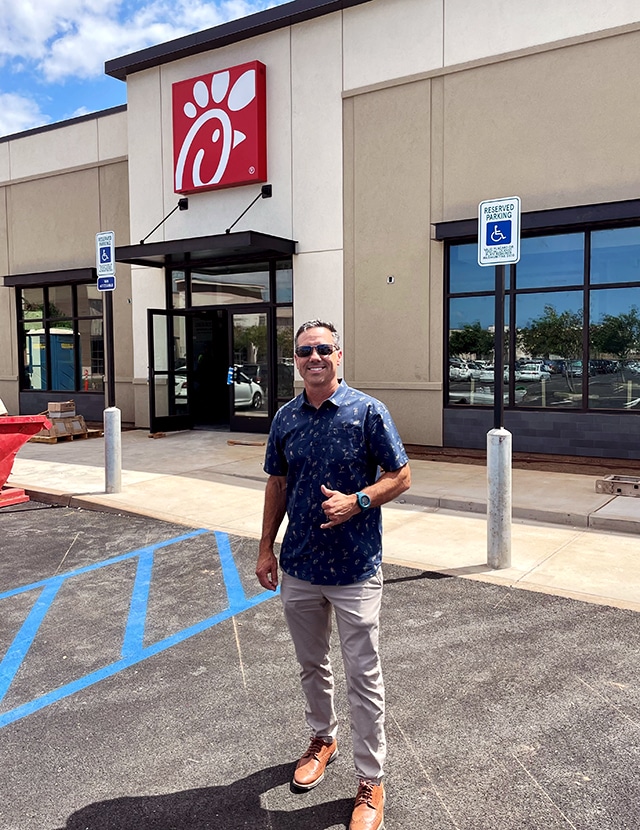|
Getting your Trinity Audio player ready...
|
Two rebellious cows with a paintbrush and a mission have been urging people to “Eat Mor Chikin” since 1995, and Don Ikeler has been supporting these bovine mascots since joining Chick-fil-A in 2007. As the development and construction director for the west region of the Atlanta-based restaurant chain, Ikeler is building more locations—and the company is testing more innovations so that more people can get their hands on the brand’s beloved chicken sandwich.
Though the chain is known as a Southern institution, Ikeler is currently spearheading development in Hawaii as part of the latest expansion plan. Ikeler is no stranger to a new set of variables: he deals with the desert heat in Arizona, the threat of earthquakes in California, endless rain in the Pacific Northwest, and heavy snow in Colorado.
Partnership is the key ingredient to making it all happen successfully, Ikeler says, and it’s the strength of these professional relationships that drew him to the company nearly 15 years ago. After working for quick-service restaurant competitors and in an industry where people are often only as good as their last job, he was excited to find a company that values the people with whom it works.
“Sometimes when you’re the leader, you think you need to have all the best ideas, while in reality, the best ideas often derive from our design partners and those in the field who are experiencing challenges on a daily basis.”
Don Ikeler
“I attended a presentation from a Chick-fil-A representative discussing their ‘partners’—architects, engineers, and contractors—and how they have this long-term view of that relationship,” Ikeler says. “The idea of truly partnering aligned with how I prefer to operate.”
He says that “while the strength of a restaurant brand comes from quality customer service and food, the strength of restaurant design and construction starts with quality partners.” Such partnerships are not merely transactional; they’re a constant cycle of teamwork, communication, and growth. The development director makes it a point to foster a culture of honesty and humility where the team and the project are more important than egos—his own included.
“Sometimes when you’re the leader, you think you need to have all the best ideas,” he says, “while in reality, the best ideas often derive from our design partners and those in the field who are experiencing challenges on a daily basis.”
Ikeler seeks out people who take continuous improvement seriously and who want to think about construction differently. His mind is on the future: how innovation, technology, and process changes can influence the next 100 jobs after this one. The company is busy looking at Lean construction practices, digitizing physical plans to expedite the exchange of information.
The company is also currently testing preassembled framing and panelized exteriors at different locations. These systems require a significant amount of upfront planning and allow a much smaller margin for error, but down the line, they could save nearly two months of construction time.
“So many of us in this industry are perfectionists who want to make everything efficient and cost-effective right away, but a new process or method may not be perfect out of the gate,” Ikeler says. “However, through refining the process with feedback and collaboration, the goal of becoming more efficient long-term can be achieved.”

According to Ikeler, industrialized construction is a strategic bet the company is willing to make for the future of Chick-fil-A’s development.
“When implementing a new process with partners, it’s about clarifying the ‘why’ and collaborating on the best way to proceed,” Ikeler says. “When the partners understand the new process is a benefit to all parties, there is a stronger chance of success.”
He knows that in order to succeed, his partners must be able to depend on him and offer their feedback as well. Ikeler values constructive feedback as a necessary component both from and to partners. He admits that it may sound funny, but he sees time and again that partners are thankful when they are provided “opportunities for improvement.”
“They want that opportunity to improve and deliver a quality product,” Ikeler says. “And if it’s a blind spot, they are appreciative to have the chance to adjust and progress.”
As tough as it can be to balance results with relationships in an industry that often prioritizes speed and costs, it is clear to Ikeler that if you value people, the rest will follow. “If you invest in those relationships early and often,” Ikeler says, “and if those subcontractors, contractors, architects, and engineers feel like they’re a part of the team—not just a hired service but a part of the team—you’ll achieve improved speed, quality, and costs in the long term.”


